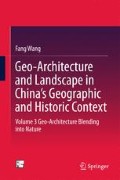Abstract
Location: Kashgar, Sinkiang Uygur Autonomous Region. Key Geographical Concept: Architectural responses to regional climate and local landform. Due to the harsh regional climate and limited building materials, the architecture and urban network of alleyways are an ingenious adaptation, bringing together Islamic culture and Uygur family values and organic growth, as well as maintaining the transition space between the exterior and the interior.
Access this chapter
Tax calculation will be finalised at checkout
Purchases are for personal use only
References
Diao, W. (2008). Study on Kashgar local dwellings on high platform area. Huazhong Architecture, (8), 235–239. (in Chinese).
Editorial Committee on the Ejina Banner Records. (1998). Ejina Banner records. Beijing: Chorography Publishing House (Fangzhi Publishing House). (in Chinese).
Editorial Committee on the Kashgar Municipal Records. (2002). Kashgar municipal records. Sinkiang: Sinkiang People’s Publishing House. (in Chinese).
Editorial Committee on the Sinkiang Civil Engineering., & Yan, D. C. (1995). Residential architecture in Sinkiang. Beijing: China Architecture and Building Press. (in Chinese).
Editorial Committee on the Vegetation Maps, Chinese Academy of Sciences. (2007a). Vegetation map of China and its Geographic Pattern: Illustration of the vegetation map of the People’s Republic of China (1: 1,000,000) (Volume I). Beijing: Geological Publishing House. (in Chinese).
Editorial Committee on the Vegetation Maps, Chinese Academy of Sciences. (2007b). Vegetation map of China and its Geographic Pattern: Illustration of the vegetation map of the People’s Republic of China (1: 1,000,000) (Volume II). Beijing: Geological Publishing House. (in Chinese).
Editorial Committee on the Vegetation Maps, Chinese Academy of Sciences. (2007c). Vegetation map of the People’s Republic of China (1: 1,000,000). Beijing: Geological Publishing House. (in Chinese).
Feng, S. W. (1988). The changes of the Heihe River (Ruoshui River) system in Hexi. Geographical Research, 7(1), 18–26. (in Chinese).
Liu, E. H. (1983). Reports of the visit to Khara-Khoto. Siping Normal University Journal (Philosophy and Social Science Edition), (2), 20–22. (in Chinese).
Lu, Y. D. (2003). Chinese residential architecture (Vol. III). Guangzhou: South China University of Technology Publishing House. (in Chinese).
Lu, S. (2005). Travel in the died town. West China Development, (3), 74–77. (in Chinese).
Ma, Y., Cao, X. Q., & Li, Z. P. (2008). Environment changes and its dynamic mechanism of the Ejina region in the lower reaches of the Heihe River. Meteorological and Environmental Sciences, 31(3), 43–47. (in Chinese).
Shen, W. R. (2007). Study on humanity and environment of Khara-Khoto. Beijing: China Renmin University Press. (in Chinese).
Song, J. H. (2008). Collecting Kashgar. Beijing: China Electric Press. (in Chinese).
Wang, X. D., Liu, J., et al. (2010). Anti-seismic remodeling and the protection of the flavorful appearance for Kashi local dwellings on high platform. Architectural Journal, (3), 78–81. (in Chinese).
Wei, D. F. (2009). Place spirit and building experience of raw-soil houses: a case of hathpase houses in Kashi. Huazhong Architecture, (3), 266–270. (in Chinese).
Wu, J. H., & Yang, S. W. (2007a). Eco-design concept in Kashgar local dwellings on high platform. Journal of Changji University, (6), 41–42. (in Chinese).
Wu, J. H., & Yang, T. (2007b). The formation of appearance style of Kashgar local dwellings on high platform. Journal of Changji University, (1), 42–44. (in Chinese).
Yang, R. (2000). Khara Khoto: The valuable references of Western Xia. Chinese Culture, (3), 55–56. (in Chinese).
Yang, T., & Mu, J. J. (2009). Influence of reginal climate on residential architecture form of Sinkiang Kashi. Shanxi Architecture, (8), 43–44. (in Chinese).
Zhang, J. M. (2007). Ejina: Deep into the uncharted frontier. Map, (3), 88–97. (in Chinese).
Zhu, Z. D., Liu, S., Gao, Q. Z., Hu, Z. Y., & Yang, Y. L. (1983). The environmental changes and desertification processes in historical period in the areas of ancient Juyan: The Heicheng region in western Inner Mongolia. Journal of Desert Research, 3(2), 1–8. (in Chinese).
Zou, W. Y. (2006). Vicissitudes of Khara-Khoto. Forward Position, (11), 249. (in Chinese).
Author information
Authors and Affiliations
Corresponding author
Rights and permissions
Copyright information
© 2016 Springer Science+Business Media Singapore
About this chapter
Cite this chapter
Wang, F. (2016). “The Language of Earth” Cases. In: Geo-Architecture and Landscape in China’s Geographic and Historic Context. Springer, Singapore. https://doi.org/10.1007/978-981-10-0489-6_10
Download citation
DOI: https://doi.org/10.1007/978-981-10-0489-6_10
Published:
Publisher Name: Springer, Singapore
Print ISBN: 978-981-10-0487-2
Online ISBN: 978-981-10-0489-6
eBook Packages: Social SciencesSocial Sciences (R0)

